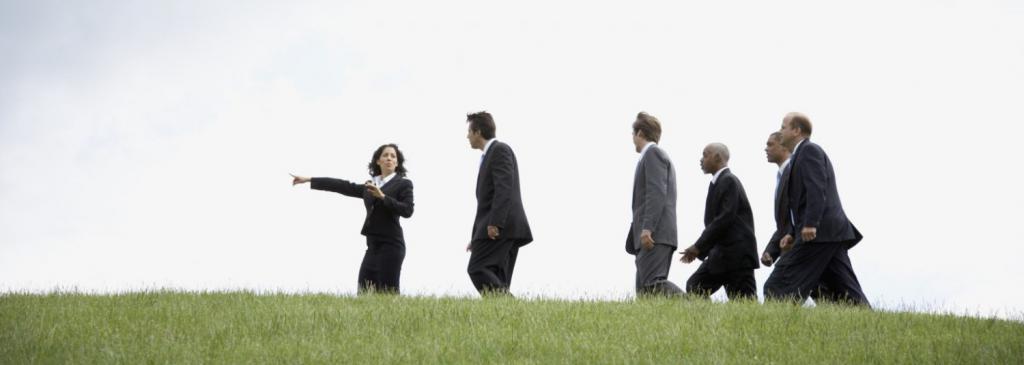Management in the most diverse areas of human activity is one of the most important functions. Of particular relevance to it was given the conditions of a market economy. For the proper management of people, the head of the organization must choose a certain style of behavior. It is to be shown in relations with subordinates, bringing them to the intended goal. In other words, for the normal functioning of the enterprise, the presence of one or another management style of the leader is necessary. This is the main characteristic of the performance of a senior manager. The role of the manager's management style cannot be overestimated. Indeed, the success of the company, the dynamics of its development, the motivation of employees, their attitude to their duties, relationships in the team and much more will depend on it.
Definition of a concept
What does the word "leader" mean? This is the one who "leads by the hand." Each organization must have a person who is responsible for overseeing all units operating at the enterprise. This type of responsibility involves monitoring the actions of employees. This is the essence of the work of each leader.
The ultimate primary goal of a senior manager is to achieve the goals of the company. The leader does this work without the help of his subordinates. And his usual manner of behavior in relation to the team should motivate to work. This is the management style of the leader. What are the roots of this concept?

The word "style" is of Greek origin. Initially, the so-called rod designed for writing on a wax board. A little later, the word "style" began to be used in a slightly different meaning. It began to indicate the nature of the handwriting. This can be said about the management style of the leader. He is a kind of handwriting in the actions of a senior manager.
The styles of a leader in managing a team can be different. But in general, they depend on the leadership and administrative qualities of the person in this position. In the process of carrying out labor activity, the formation of an individual type of leader takes place, his “style”. This suggests that it is impossible to find two identical bosses with the same style. Such a phenomenon is individual, since it is determined by the specific characteristics of a particular person, reflecting his particularity of working with staff.
Classification
It is believed that the person who is happy to go to work every morning is happy. And this directly depends on his boss, on which manager uses the management style, on his relations with his subordinates. Management theory paid attention to this issue at the dawn of its creation, that is, almost a hundred years ago. According to the concepts put forward by her, already at that time there were a number of styles of work and management of the leader. Somewhat later, others began to join them. In this regard, modern management theory considers the presence of many leadership styles. Let us describe some of them in more detail.
Democratic
The basis of this leadership style is the participation of subordinates in decision-making with the division of responsibility between them. The name of this type of work of a senior manager came to us from the Latin language. In it, demos means "power of the people." The democratic management style of the leader is today considered the best.Based on the data of the studies, it is 1.5-2 times more effective than all other methods of communication between the boss and his subordinates.
If the leader uses a democratic management style, then he relies on the initiative of the team. At the same time, there is equal and active participation of all employees in the processes of discussing the goals of the company.
In a democratic style of leadership, an interaction occurs between the leader and subordinates. At the same time, a feeling of mutual understanding and trust arises in the team. However, it is worth noting that the desire of a senior manager to listen to the views of company employees on certain issues does not occur because he does not understand something. The democratic management style of the leader suggests that such a boss is aware that new ideas arise during the discussion of problems. They will certainly allow you to speed up the process of achieving the goal and improve the quality of work.

If out of all the styles and methods of management the leader chose a democratic one for himself, this means that he will not impose his will on his subordinates. How will he act in this? Such a leader would prefer to use incentive and persuasion methods. He will resort to sanctions only when all other methods are completely exhausted.
The democratic management style of the leader is most favorable in terms of psychological impact. Such a boss shows sincere interest in employees and gives them friendly attention, taking into account their needs. Such relationships positively affect the results of the work of the team, the activity and initiative of specialists. People are satisfied with their own work. Satisfies them and the situation in the team. The cohesion of employees and favorable psychological conditions have a positive impact on the physical and moral health of people.
Of course, management styles and managerial qualities are concepts that are closely related. So, with the democratic nature of communication with subordinates, the boss should enjoy high authority among employees. He also needs to have remarkable organizational, intellectual and psychological-communicative abilities. Otherwise, the implementation of this style will become ineffective. The democratic type of leadership has two varieties. Let's consider them in more detail.
Advisory style
When using it, most of the problems that the team faces are resolved at the time of their general discussion. A leader who uses a consultative style in his activities often consults with subordinates, without showing his own superiority. He does not shift the responsibility on employees for those consequences that may occur as a result of decisions made.

The heads of the consultative type of leadership make extensive use of two-way communication with their subordinates. They trust employees. Of course, only the head makes the most important decisions, but specialists are given the right to independently solve specific problems.
Participating style
This is another kind of democratic type of leadership. His main idea is to involve employees not only in the adoption of certain decisions, but also in the exercise of control over their implementation. In this case, the leader fully trusts his subordinates. Moreover, communication between them can be described as open. The boss behaves at the level of one of the team members. At the same time, any employee is given the right to freely express their own opinions on various issues without fear of subsequent negative reactions. For failure in work in this case, the responsibility is divided between the manager and subordinates.This style allows you to create an effective system of motivation. This makes it possible to successfully achieve the goals that the company faces.
Liberal style
This type of manual is also called free. After all, it implies a tendency to condescension, tolerance and undemanding. The liberal management style is characterized by complete freedom of employee decisions. At the same time, the leader takes minimal part in this process. He removes himself from the functions assigned to him to oversee and control the activities of subordinates.
We can say that the types of leaders and management styles are closely related. Thus, a liberal attitude in the collective allows a person who is not competent enough and unsure of his official position. Such a leader is able to take decisive steps only after receiving instructions from a superior. He avoids responsibility in every way when receiving unsatisfactory results. The solution of important issues in the company where such a leader works, often takes place without his participation. To consolidate its authority, a liberal only pays his subordinates undeserved bonuses and provides various kinds of benefits.

Where can such a direction be chosen from all existing managerial management styles? Both the organization of work and the level of discipline in the company should be the highest. This is possible, for example, in the partnership of well-known lawyers or in the Writers' Union, where all employees are engaged in creative activities.
The liberal management style from the point of view of psychology can be considered in two ways. Everything will depend on what kind of specialists this manual is implemented. A similar style will get a positive result where the team consists of responsible, disciplined, highly qualified employees who are able to independently carry out creative work. Similar guidance can also be successfully implemented if the company has knowledgeable assistants.
There are also such teams in which subordinates command their boss. He is known to them simply as a "good man." But this cannot go on for long. When any conflict situation arises, dissatisfied employees cease to obey. This leads to the emergence of an conniving style, leading to a decrease in labor discipline, to the development of conflicts and other negative phenomena. But in such cases, the manager simply eliminates himself from the affairs of the enterprise. The most important thing for him is to maintain good relations with his subordinates.
Authoritarian style
It is understood as an imperious type of leadership. It is based on the desire for approval by the boss of his influence. The head of an authoritarian management style provides company employees with only a minimal amount of information. This is due to his distrust of his subordinates. Such a leader seeks to get rid of talented people and strong workers. The best in this case is the one who is able to understand his thoughts. Such leadership style creates an atmosphere of intrigue and gossip at the enterprise. At the same time, the independence of workers remains the most minimal. Subordinates seek to resolve all arising issues with the management. After all, no one can imagine how the authorities will respond to a particular situation.
The leader of an authoritarian management style is simply unpredictable. People do not even dare to inform him of the bad news. As a result, such a boss lives in complete confidence that he did everything exactly as he expected. Employees do not ask questions and do not argue, even in cases where they see significant errors in the decision made by the head.The result of the activities of such a top manager is the suppression of the initiative of subordinates, which interferes with their work.
In an authoritarian style of leadership, all power is concentrated in the hands of one person. Only he is able to single-handedly solve all issues, determine the activities of subordinates and not give them the opportunity to make independent decisions. Employees in this case do only what they are ordered to. That is why all the information for them is minimized. The head of the authoritarian style of team management tightly controls the activities of his subordinates. Such a boss has enough power in his hands to impose his will on the workers.

In the eyes of such a leader, a subordinate is a person who is disgusted with work and avoids it whenever possible. This is the reason for the constant coercion of the employee, control over him and the implementation of punishments. In this case, the mood and emotions of subordinates are not taken into account. The leader has remoteness from his team. At the same time, the autocrat specially appeals to the lowest level of needs of his subordinates, believing that for them he is most important.
If we consider a similar leadership style from the point of view of psychology, then it is the most unfavorable. After all, the leader in this case does not perceive the employee as a person. Employees are constantly suppressed creative manifestations, because of which they become passive. People are dissatisfied with work and their own position in the team. The psychological climate at the enterprise also becomes unfavorable. Intrigues often arise in the team and sneaks appear. This increases the stress on people, which is harmful to their moral and physical health.
The use of an authoritarian style is effective only in certain circumstances. For example, in the conditions of military operations, in emergency situations, in the army and in the collective, in which the consciousness of its members is at the lowest level. The authoritarian leadership style has its own varieties. Let's consider them in more detail.
Aggressive style
The manager, who adopted this type of personnel management, believes that by their nature people are mostly stupid and lazy. Therefore, they try not to work. In this regard, such a leader considers it his duty to force employees to fulfill their duties. He does not allow himself participation and softness.

What can mean the fact when a person chose it is aggressive among all management styles? The personality of the leader in this case has special characteristics. Such a person is rude. He limits contact with subordinates, keeping them at a distance. When communicating with employees, such a boss often raises his voice, offends people and actively gestures.
Aggressively supple style
This type of leadership is characterized by its selectivity. Such a boss is aggressive towards his employees and at the same time, helpfulness and compliance with respect to a higher governing body.
Selfish style
It seems to the leader who has accepted this type of personnel management for himself that he alone knows everything and knows how. That is why such a boss assumes responsibility for the sole solution of issues of collective activity and production. Such a leader does not tolerate the objections of his subordinates and is inclined to hasty conclusions, which are not always true.
Kind style
The basis of this type of relationship between the leader and subordinates is authoritarianism. However, the boss still provides his employees with the opportunity to participate in some decisions, while limiting their scope of activities.The results of the work of the team, together with the punishment system, which occupies a dominant position, are also evaluated by some rewards.
Finally
The individual management style of the leader can be very different. At the same time, all its types listed above cannot be found in pure form. Here, only the predominance of certain characteristics can take place.

That is why determining the best leadership style is not easy. The top manager needs to know the above classification and be able to apply each of the categories of personnel management depending on the situation and the presence of a specific task. This, in fact, is the art of a true leader.
